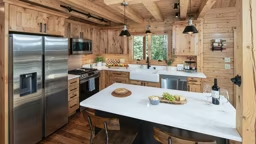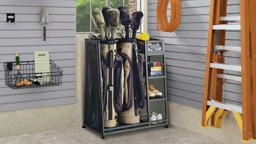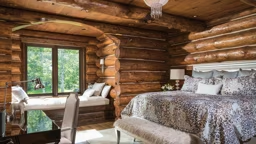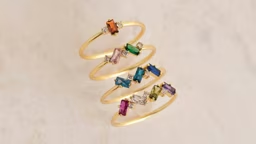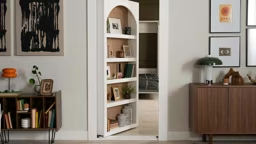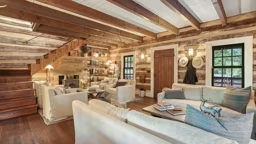
Photo: Heidi Long / Home: Bigfork Builders, Locati Architects
Interior designer Crystal Johanson of Locati Architects worked alongside colleague Amanda Heys to add the finishing touches to this home Montana home. See the full tour here.
By Lindsay Sutherland
The phone rang. I answered, “Thank you for choosing Caribou Creek Log & Timber Homes. How may I help you?” Lynn Fleming of Xact Interiors out of Coeur D’Alene, Idaho, was on the other end. She was calling to inform me that she was placing a lighting order with a vendor for our client in Troy, Montana. As the office manager, I would need to set up an account, and as I did, I began to ponder “What really is the point of hiring an interior designer?” I figured it couldn’t be that hard to pick out lighting fixtures. My curiosity got the best of me, so I asked Lynn if she would share what she was doing for our client. Not only was I amazed at the depth of her involvement in the project, I was floored at how truly important an interior designer is in planning and building a log home.
To start, let’s clarify the difference between an interior decorator and an interior designer. Decorators are focused on making things look pretty: where pictures should be hung, coordinating colors, placing furniture, etc. Designers, on the other hand, are much more involved in the home’s layout, and when it comes to log homes, this can be trickier than traditionally framed houses.
Making Informed Design Decisions
There are a few challenges in log home design that aren’t evident in other types of construction, and proper illumination tops the list. Logs absorb light, and, as such, they run the risk of feeling dark if an adequate lighting plan isn’t in place. A full understanding of lumen output, the color rendering of the light from warm to cool and fixture placement are important elements a skilled designer brings to the table. “Log homes need to be well lit, which sometimes involves some hidden lights to create a nice glow,” Lynn explains. “You want lighting that celebrates the log structure!”
And it’s not just the brightness-factor that can be an issue in a log home. Often homeowners or inexperienced designers choose fixtures that are too small and clash against the stately logs. “Fixtures need to hold their own against bold rugged logs,” Lynn explains. “This is something a designer who’s experienced with log homes will understand.”
Getting Good Guidance
Another huge benefit to hiring an interior designer is that often he or she will know design tricks that the homeowner is unaware of, and bringing fresh ideas to the project can make a substantial difference in the end. Lynn shares that many of her clients tell her, “It’s still our house Lynn — we picked everything out — but it is more than we could have delivered on our own.”
When is the right time to bring this magical person into the process? It’s best to pull him or her into the loop early, ideally as the plans are drafted, to reap the maximum benefit of an interior designer’s insight. Key elements can be implemented that would be tough to revise after construction is complete, such as curb-less showers, entertainment-system connections, washer/dryer locations, external outlets for holiday lights — even simple things like broom closets, which are often overlooked. All of these are examples of the forethought a designer brings to the table.
So, you may have had the same initial thought that I did — that choosing fixtures can’t be that hard, so why would I need a pro? But when you learn the scope of the choices at hand, your enthusiasm for taking it on yourself can quickly turn to dread, and what should be one of the best experiences of your life — designing a custom log home — could be in danger of becoming an exhausting chore. Consider enlisting the help of an experienced log home interior designer to guide you and bring the joy back into your home’s design.

Photo: Pexels
How to Identify a Good Designer
Knowing what to avoid in an interior designer is just as important as knowing what to seek out.
For starters, licensing requirements are in place in Canada and most U.S. states. Whenever possible, hire a licensed designer. This ensures that he/she knows more than decorating and will understand engineering and construction, which are instrumental in design. Most licensed designers have 4 to 5 years of education and another 4 to 5 years of field experience. Not only do they have to pass a rigorous practical exam, but also a lengthy written one. Look for NCIDQ, CIDQ, ASIS and IIDA designations and you’ll know they are trained and licensed professionals.
When designers are working as part of a firm, their fee may be worked into the cost of the overall project. But for designers who work as independent contractors, the fee structure is either a flat project fee or an hourly rate. If the designer charges by the hour, he or she should be able to give you a ballpark figure for what their portion will cost. According to designer Lynn Fleming, in a $500,000 house, if a designer costs more than $10,000 he or she is just gouging.
A Bit of Free Interior Design Advice
Interior designer Lynn Fleming has extensive experience with log homes, and she has a few pro pointers to share.
Keep the log home element.
For example, installing Euro-style cabinets in a log home really only works if the entire log home is done in a minimalist style. Keep it interesting, but stay true to the log home aesthetic.
Balancing textures is important.
Log homes have a lot of horizontal lines. Including stonework that changes the geometry is pleasing to the eye. This can be incorporated from everything from fireplaces to flooring choices.
Make the ceiling white.
Though stained tongue-and-groove is popular, Lynn proposes that white drywall or a whitewashed stain on the ceiling will help reflect natural light and show off the beauty of the trusses.
Take care with trends.
Gray log homes are trending, but need to be done carefully so as not to look like old worn-out log structures.
Mix materials.
You don’t want your log home to look like a patchwork quilt, but introducing other elements — particularly metal — is a great way to both complement and take a break from the wood.
Design themes should flow.
Whether it’s classic country or mountain modern, keep the design thread going, but take care to not overdo it. Know when and where to change things up to keep the interior feeling fresh and lively.See also: How to Make Your Log Home Picture-Worthy




